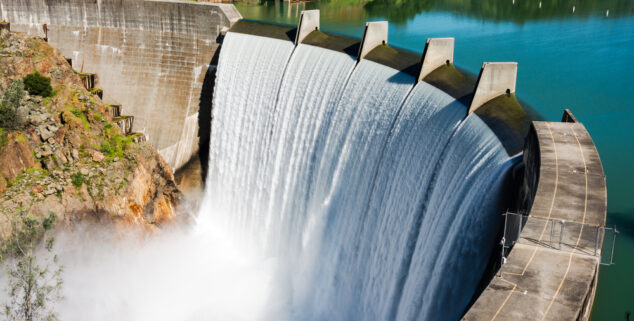Opinion
Dam removal supports California’s 30×30 Goals
 Image by Gary Saxe
Image by Gary SaxeOPINION – California has hundreds of outdated dams, small and large, that no longer serve a function. These obsolete dams litter our rivers and streams, block fish passage, and create costly liabilities to communities. We need to accelerate our pace of dam removal as a nature-based strategy for restoring freshwater systems and preparing for increasing threats from climate change.
Dam removal fits nicely within California’s effort to protect 30 percent of its land and coastal waters by 2030 (30×30). After all, rivers and streams connect the land to the coast and along the way, they provide critical habitat for fish and wildlife, drinking water for towns and cities, irrigation water for farmers and ranchers, first foods and important ceremonial spaces for Indigenous Peoples, and recreational opportunities for many.
The 30×30 goal rests firmly on science and provides a simple yet compelling approach for addressing the growing biodiversity crisis borne out of climate change, development pressures, and extractive land uses. It has been adopted by many states and countries, including the United States under President Biden. But nowhere is it more on course for success than in California, thanks to the state’s strong leadership and active partner engagement.
California’s 30×30 initiative focuses on conserving biodiversity, building climate resilience, and creating equitable access to nature through projects and actions that will be undertaken by diverse stakeholders across the state. These projects will bring many benefits to communities, including newly conserved private lands, agricultural and working land conservation easements, Tribal land back and co-stewardship projects, new parks, wildlife crossings, floodplain and habitat restoration, and national monument designations.
Removing and/or modernizing dams is emerging as an innovative and powerful strategy to support California’s 30×30 goals, while adding the overlooked but critical benefit of restoring healthy river function for fish, wildlife, and people, especially as extreme heat, drought, and flood impacts intensify. Without healthy freshwater resources, 30×30’s intended biodiversity outcomes are weakened.
Removing and/or modernizing dams is emerging as an innovative and powerful strategy to support California’s 30×30 goals.
The Klamath Dam removal project is a model for how dam removal benefits ecosystems, communities, and Tribes. For more than two decades, a committed group of Klamath area Tribes (including the Yurok, Karuk, Hoopa, Shasta, and Klamath Tribes) and nonprofit organizations—supported by determined government leadership and funding from California and Oregon—organized, researched, advocated, litigated, and conducted planning and permitting for the removal of four lower Klamath River Dams. Their perseverance paid off. The Copco 2 Dam was removed this summer and the other three dams are slated for removal in 2024.
The project will deliver outcomes that are squarely embedded in the promise of California’s 30×30 movement, including:
400 river miles opened for fish, wildlife, and people to swim, roam, hike, and paddle.
7,027 acres transferred into public ownership for public interest purposes such as habitat restoration, parks, and public recreation that will count towards reaching the 30×30 target.
Tribal sovereignty strengthened for the region’s Tribes that have forever relied on Klamath Basin natural resources for sustenance, community, and cultural practices.
The Klamath region made more resilient to drought and climate impacts through a comprehensive basin-wide restoration effort that will enhance habitat, improve watershed health and water quality, modernize water infrastructure, and mitigate the risks of droughts and floods.
Several other dam removal projects are advancing across the state—including on the Eel and Ventura rivers—having learned critical lessons from the Klamath coalition on how best to do this work. And there are many more projects yet to be identified and supported.
This work requires significant funding, patience, and community buy in, but the benefits are worth it. They include improved river function, return of native fish populations, restoration of Tribal traditions, water conservation, upgraded infrastructure for farmers and ranchers, expanded recreation benefits, reclaimed floodplains that provide wildlife habitat, economic growth, comradery among unlikely partners, and the list goes on. The dam does not need to be big to provide benefits. In fact, a series of small dam removals assembled within a watershed can yield massive benefits.
No one should be fooled by the elegant simplicity of 30×30, nor surprised by the transformative watershed benefits of dam removal. Behind the increasingly familiar 30×30 maxim lies a comprehensive, science-based strategy for addressing the state’s biodiversity crisis, building climate resilience, and providing equitable access to nature. But the promise of 30×30 will only be achieved with sustained leadership and commitment of resources by the state, matched by the continued engagement, tenacity, and imagination of partners undertaking small and large projects that deliver nature’s benefits to all communities.
Julie Turrini is director of Lands, Rivers, and Communities at Resources Legacy Fund where she leads the Open Rivers Fund.
Want to see more stories like this? Sign up for The Roundup, the free daily newsletter about California politics from the editors of Capitol Weekly. Stay up to date on the news you need to know.
Sign up below, then look for a confirmation email in your inbox.

Leave a Reply